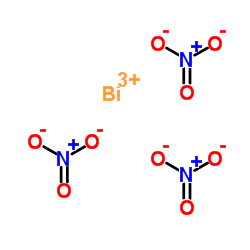The efficiacy of bismuth subnitrate against genotoxicity and oxidative stress induced by aluminum sulphate.
Hasan Turkez, Fatime Geyikoglu
文献索引:Toxicol. Ind. Health 27(2) , 133-42, (2011)
全文:HTML全文
摘要
Aluminum (Al) is commonly used in industrial processes and drugs and is thought to induce erythrocytes damage via activation of oxidative stress. Recently, bismuth (Bi)-containing drugs are used in the treatment of various diseases. However, uncertain effects of Bi in blood tissue may participate in the therapeutic efficacy of Bi compounds as related to metals. Hence, this study aimed to determine the roles on human blood cells of the various concentrations of aluminum sulphate (Al(2)(SO(4))(3)) and bismuth subnitrate (BSN), separate and together. With this aim, oxidative status was assessed on erythrocytes by measuring following oxidative stress markers: reduced glutathione (GSH), superoxide dismutase (SOD), glucose-6-phosphate dehydrogenase (G-6-PDH) and catalase (CAT). Two chemicals were tested for their ability to induce cytogenetic change in human lymphocytes using assays for chromosome aberrations (CAs) and sister chromatid exchanges (SCEs). Our results showed that high dose of Al(2)(SO(4))(3) (20 µg/mL) caused oxidative stress and increased CA and SCE frequencies. Whereas, BSN doses did not change CA and SCE rates. Moreover, it led to changes of antioxidant capacity at different concentrations. After concomitant treatment with Al(2)(SO(4))(3) and BSN, the effects of BSN doses were different on enzyme activities and decreased the genotoxic damage. However, the high dose of BSN and Al(2)(SO(4))(3) was shown to enhance the frequencies of CAs and SCEs in a synergistic manner. In conclusion, BSN could be effective in the protection against the blood toxicity of Al(2)(SO(4))(3).
相关化合物
| 结构式 | 名称/CAS号 | 分子式 | 全部文献 |
|---|---|---|---|
 |
次硝酸铋
CAS:1304-85-4 |
BiN3O9 |
|
Bismuth iodoform paraffin paste: a review.
2011-09-01 [J. Laryngol. Otol. 125(9) , 891-5, (2011)] |
|
Comparison of the efficacy of cloxacillin alone and cloxacil...
2008-05-24 [Vet. Rec. 162(21) , 678-84, (2008)] |
|
Physiology of sulfide in the rat colon: use of bismuth to as...
2002-04-01 [J. Appl. Physiol. 92(4) , 1655-60, (2002)] |
|
The use of an internal teat sealant in combination with clox...
2010-10-01 [J. Dairy Sci. 93(10) , 4582-91, (2010)] |
|
In vivo distribution of bismuth in the mouse brain: influenc...
2005-09-01 [Basic Clin Pharmacol Toxicol. 97(3) , 188-96, (2005)] |